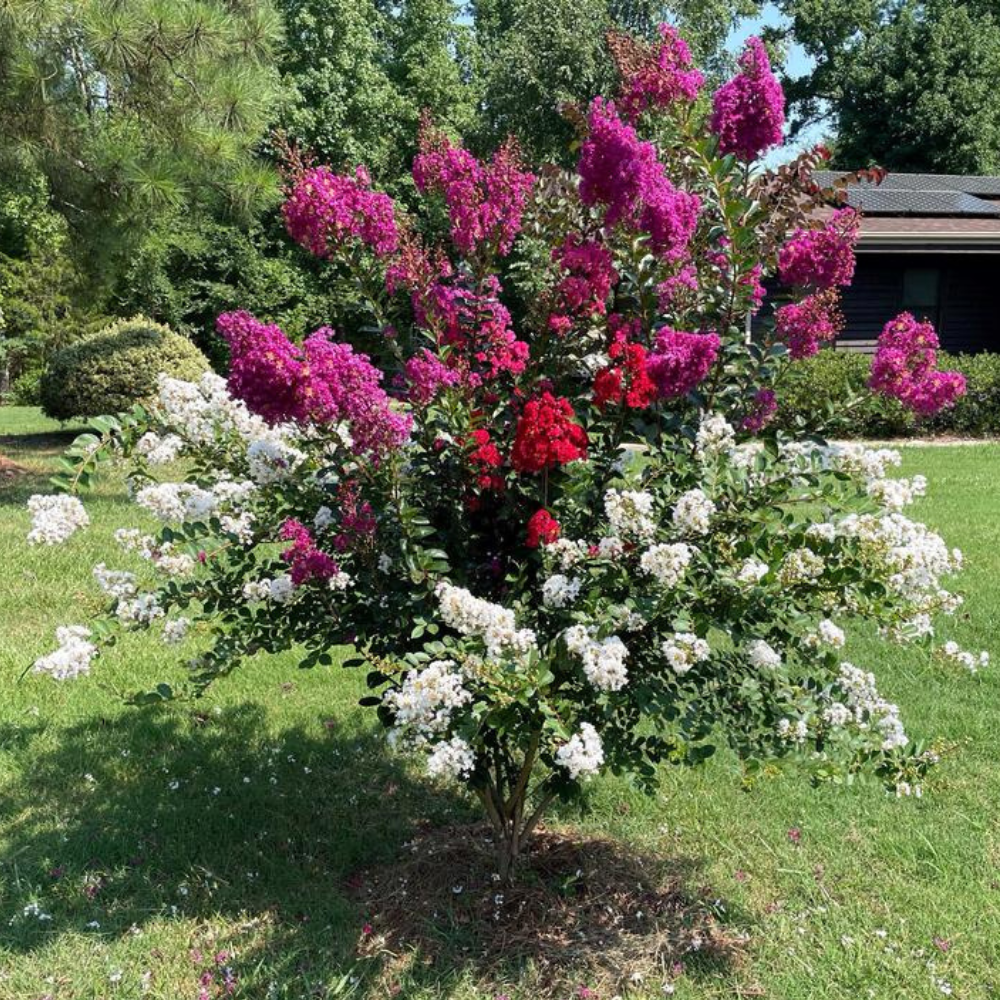Combining Crape Myrtles
Combining Crape Myrtles – Create a Stunning Multi-Colored Display!
Why settle for just one color when you can turn your garden into a breathtaking masterpiece with Combining Crape Myrtles? Imagine a spectacular display of pink, red, purple, and white blooms all in one space—it’s easier than you think! With a little planning and the right combination of varieties, you can enjoy a vibrant, ever-changing floral show all summer long.
The key to Combining Crape Myrtles successfully is choosing complementary colors (that part is up to you🙂), and matching growth habits. Want a bold, fiery display? Try planting the Miss Francis (bright red) alongside the Miss Sandra (deep purple) and the Natchez (pure white) for a striking contrast. Looking for softer, romantic tones? Mix the Sarah's Favorite (crisp white) with the Muskogee (lavender) and the Biloxi (soft pink) to create a whimsical, dreamy palette.
But it’s not just about color—Combining Crape Myrtles also means considering growth habits. Some varieties grow into majestic, towering trees, while others remain compact and bushy. Want a natural privacy screen? A mix of dwarf, medium to tall crape myrtles (in a row or column), in alternating colors creates a stunning, colorful hedge that also blocks unwanted views!
For the most eye-catching display, plant crape myrtles in clusters of three or more. This enhances the multi-tonal effect and makes each individual color pop even more. Don’t forget to space groups properly—giving each tree(s) enough room to grow and flourish will ensure your blooming masterpiece lasts for years to come.
Worried about care? Combining Crape Myrtles doesn’t mean extra work! These trees are heat-tolerant, drought-resistant, and low-maintenance, making them perfect for any gardener. Just give them plenty of sunlight, occasional pruning, a little bit of fertilizer occasionally and proper watering, they’ll reward you with non-stop color all summer long.
Ready to start Combining Crape Myrtles for your dream garden? Check out our expert guide and shop our rare and unique crape myrtle varieties today! 🌸✨🌱
Combining Crape Myrtles
Combining different varieties and colors of crape myrtle is a fun and EASY way to create a visually stunning effect. Through a process called inosculation, crape myrtles will fuse together to form a single living tree. Your neighbors will wonder where you got such an unusual plant.
But, like anything else, there are a few things you should consider when employing this technique.
- How Many you Should Combine. Well, the minimum is obviously two for different colors. Most people do 3-4 varieties. I personally have one with 6 varieties and it's beautiful and doing just fine.
- Choose varieties that have similar growth rates, patterns and mature size. This is very important first step as, over time, the trunks will fuse to create one plant. Choose plants from Bijou™ Micro Minis, Miniatures, Dwarfs or Passion™, Mediums or Standards. The larger rare varieties are best as standalone trees.
For example, let's say you'd like your plants to mature to about 10ft tall. That means you would pick plants from the Dwarf or Passion™ selections.
Now imagine you'd like a shade tree with 4 different colors. Then you would choose 4 Standards with similar growth rates and mature heights.
Why Does Mature Size, Growth Rates and Patterns Matter?
It matters because we want you to be happy with your choices for many years to come. Say you wanted to plant a miniature with a dwarf and a standard. The idea of three tiers of color is great, so why can't we do that? Simple: the standard is going to outgrow and shade out the dwarf and certainly the miniature. The result will be a large standard that reliably blooms because it's getting enough sun, and it is absorbing more nutrients. The dwarf will survive longer than the miniature, but it will be thin, without many blooms. The miniature will likely live a year or two but will bloom very little and become extremely thin before it bites the dust.
*We're telling you this not to dissuade you from trying to combine your own colors. NOT AT ALL! We want you to make an informed decision that will help you to grow the perfect multi-colored tree, something you'll be proud of in your front yard. *
- Select your perfect colors. The fun part! Over the years we've found that a lot of people prefer a stark contrast of color: bright red, crisp white and rich dark purple for example. But others prefer the "hombre" look and choose colors like snow white, rich lavender and dark purple. Honestly there's no wrong color combination. It's entirely up to you.
How to Combine Your Crape Myrtles
There are a few ways you can do this. All work just fine. Personally, we like to do it the easy way.
- The Easy Way. Plant your trees in the same hole with the root balls touching. This is perfect for Bijou™ Micro Mini's and Miniatures. The result will be a multi-trunk plant that blooms different colors, and over time the trunks and suckers will fuse together to become a single tree with different color flowers.
- The Medium, but Still Easy Way. Take each plant out of the pot, shake as much soil off as possible and lay them on a table. If the trunks are thin and flexible enough (available on request), you can even twist or braid them together. Next, bind them with jute twine or other natural fiber, at the soil line and every 6in up until you run out of tree. Plant like normal. This speeds the fusion process and will yield a single trunk tree with different color flowers.
- The Not so Easy Way that is Somewhat Difficult and very Time Consuming. Grafting. Can you graft branches/trees onto your largest root stock? Absolutely. Is it a time-consuming task that might work or might not? Absolutely. We've done it hear at the nursery, and it certainly works. The use of a greenhouse is a plus. If you want to try grafting, there are a number of YouTube video's online that will show you how to graft fruit trees. The same principles apply for crape myrtles.
We Highly recommend the "Easy" or "Medium but Still Easy" methods. Success is extraordinarily easy to achieve, and you end up with the same look, if not better than if you went through the trouble of grafting them.
Anything Else you Should Know?
There are a few things to keep in mind after the hard parts of choosing varieties, colors and planting them (the hardest being choosing colors).
- Watering? They're going to wilt after shipping and transplanting, all crape myrtles do. The key will be keeping the soil lightly moist. This means that you don't necessarily need to water more often, but when you water make sure to do so thoroughly.
- Fertilizing? As with watering you won't need to do it more often than you would normally. But when you do, just add a little more. Not too much at first: work your way up a teaspoon at a time and see how they react.
- Pest Control? The same as for any other crape myrtle.
- Growing Oddly? Don't worry, you may have one or two in your combo that are growing faster than the others. They are individual living things after all. This just means that the larger one has become established more quickly. Prune it back to allow the others to get equal sunlight. They'll all catch up in time.
That's about it. Combining crape myrtles for a striking multi-color show all summer long is extremely easy.
Do We Offer Pre-Combined Plants?
Nope, not yet anyway. And there's only one reason: everyone wants something a little different. We allow our patrons to make their own decisions on what varieties and colors they want to combine. And we're always here to help with any questions you may have.
*YES, we DO Plan to offer combined plants in the future. We will take the most popular color combinations in the size group and introduce a whole new Southern Charm Crape Myrtles Exclusive. Sign up for our Monthly Newsletter and We'll let you know just as soon as they're ready! *


